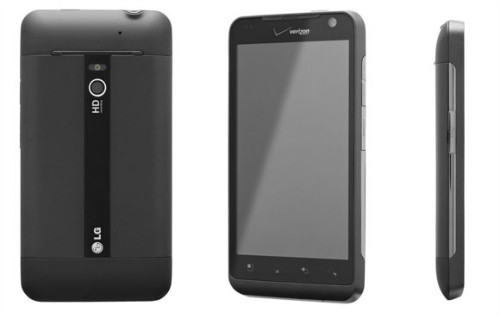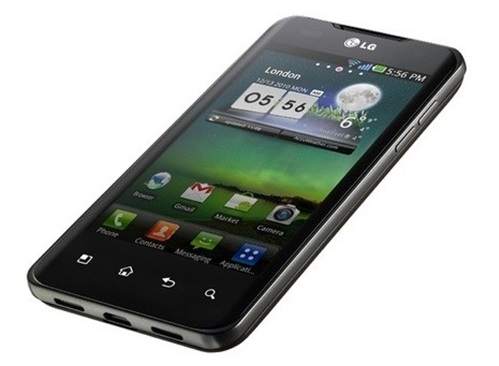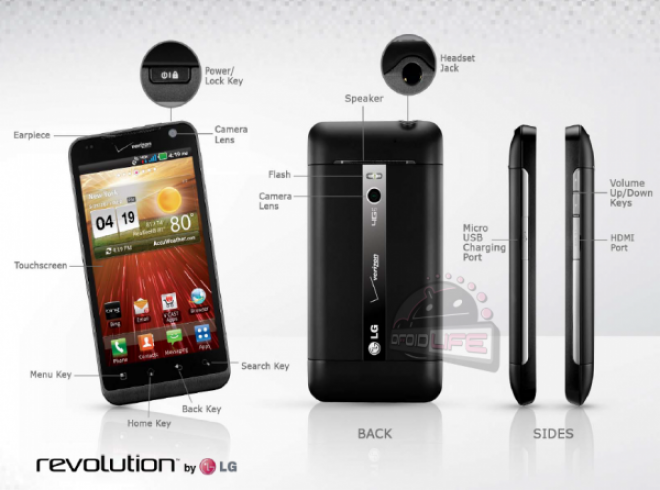The LG Revolution is one of Verizon’s latest powerhouses running on their 4G LTE network. Compared to Verizon’s other two 4G devices, the LG Revolution offers very similar specs. It’s equipped with a single core Snapdragon 1GHz processor, Bluetooth 3.0, WiFi 802.11 b/g/n, HDMI, a 5-megapixel back camera, a 1.3-megapixel front-facing camera, and a 4.3-inch 480 x 800 pixel TFT display. Like most current Android phones, the Revolution is still running Android 2.2 Froyo, and not 2.3 Gingerbread. However, the LG Revolution does come with the Netflix app preinstalled. Only a handful of devices currently support the Netflix Android app, so this can be a huge draw for some people.
The LG Revolution is a very sleek looking phone. Compared to Verizon’s Thunderbolt and Droid Charge, the Revolution is the best looking (well, in my opinion). It has a very compact and sturdy form factor, with the volume and HDMI on the right side and mini-USB port on the left. On top, there’s a standard headphone jack and a power/wake button. Nothing is on the bottom of the device except a small pinhole for the microphone, and on the back you’ll find a speaker, LED flash, and the 5-megapixel camera. Along the bottom of the front are the typical menu, home, back, and search buttons, and the speaker and front-facing camera are along the top. You’ll also find a small notification light on the front of the device. The notification light is a tiny spec, but the LED light is plenty bright to get your attention.
The specs of the LG Revolution combine to make a pretty decent phone. The 5-megapixel back camera takes very detailed pictures, and high quality 720p HD videos. As is the case with any smartphone camera, the lighting has a huge effect on the quality of the picture. We found some colors to be washed out when in direct sunlight. The front-facing camera has decent quality, enough to provide a good experience for video chatting.
The software that comes with the Revolution is a bit disappointing, as it comes with the outdated Android 2.2 Froyo. With such a “revolutionary” device I would expect it to have the latest and greatest version of Android. Froyo was a great improvement to the Android OS, but Gingerbread is the latest and should be on any new phone. LG has added a custom skin on top of Froyo, which tries to make the software easier to navigate and use. The app tray is now divided into categories, the widget screen more closely resembles the app tray, and the notification drawer has been tweaked to include a few toggle buttons. Unfortunately, the LG Revolution also comes with a hefty amount of bloatware. Apps you probably don’t want, but are there and are not un-installable. As mentioned earlier one of these is the Netflix application, which we are more than happy to have available. The rest, however, we would do just fine without.
Using the LG Revolution is a lot like using most other smartphone’s currently available. While it’s a great phone and there aren’t many negatives, there’s also nothing about it that screams must-have. 4G LTE is nice to have, but it’s power-hungry and lacking widespread availability, making it an unused feature to many. Verizon is quickly growing their LTE network, but people aren’t going to see it as a killer feature until it’s as large as their 3G network. The LG Revolution is a great phone if you want a 4G device, but I’m not sure it lives up to it’s name. If you truly want your next phone to be ahead of its time, you might want to hold out for something else.



Comments
One response to “Do the Revolution”
[…] no doubt about that, but there’s really nothing that makes it stand out above other Verizon phones. It’s the thinnest LTE phone on the network, but definitely not the thinnest smartphone […]